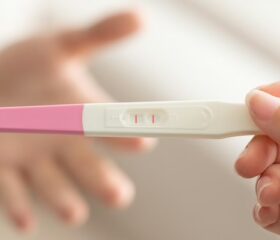How Your Cervical Mucus Changes with Ovulation
If you’ve noticed changes to your vaginal discharge around the middle of your menstrual cycle, it could be your body’s way of signaling you’re about to ovulate.

- What is cervical mucus (ovulation discharge)?
- How your cervical mucus changes throughout your menstrual cycle
- How to use your cervical mucus to improve your fertility awareness
- How to check your ovulation discharge
- Which factors can affect your ovulation discharge?
- When to see your doctor about your ovulation discharge
- Final thoughts
Around the time you ovulate (release an egg to be fertilized), your body goes through hormonal shifts that cause changes in your vaginal discharge’s texture, consistency, and color. Think of these cues as a natural indicator of your fertility.
Here’s what you need to know about how these changes to your vaginal discharge affect your fertility, what they mean, and what factors influence them.
What is cervical mucus (ovulation discharge)?
Your cervix secretes a gel-like substance called cervical mucus, which may show up in your underwear as discharge. This mucus is primarily made up of water and beneficial bacteria. It lubricates and cleans your vagina, while maintaining its natural pH balance to prevent infections. 1 2
Your discharge changes in volume and appearance around the time when you ovulate (when your egg gets released and waits to get fertilized). 3 This type of mucus is often known as ovulation discharge, fertile discharge, or fertile cervical mucus.
What normal discharge looks like
What’s “normal” for each person varies. You might notice vaginal discharge every day, or not as often. How light or heavy it is can also depend on where you are in your cycle.
Generally speaking, you’ll usually produce a relatively small amount of discharge, and it’ll be either white or clear, without a strong smell. 4
How your cervical mucus changes throughout your menstrual cycle
During your menstrual cycle, your discharge undergoes several changes in color, texture, and amount due to your fluctuating levels of certain hormones—in particular, estrogen and progesterone. 1 5
Here’s a breakdown of the typical cervical mucus stages: 6 7 8 9
- Dry phase (days 1–4): After your period (during which your mucus probably won’t be noticeable due to the presence of blood), you may see little to no noticeable cervical mucus for a few days. This is due to your lower levels of estrogen, which can cause vaginal dryness.
- Sticky phase (days 5–8): Your discharge may become cloudy with a thick and chunky consistency similar to paste or glue. Incidentally, this can slow down or restrict sperm mobility.
- Creamy phase (days 8–11): After that, your discharge will become pearly white or creamy yellow, with a lotion-like consistency. This thickness will still make it pretty hard for sperm to move around.
- Watery phase (days 10–13): Before you ovulate (usually midway through your cycle), your cervical mucus will become clearer and more watery. Sperm can move more easily through this type of mucus. You’re considered especially fertile during this stage.
- Egg white discharge phase (days 11–14): One to two days before ovulation, your cervical mucus will become clear, slippery, and stretchy, resembling raw egg whites. This consistency allows sperm to swim through your cervix even more easily. You’re very fertile at this point. 10
Once ovulation is over, your progesterone levels rise, causing your cervical mucus to decrease in volume and become thicker and stickier, like bubble gum. 9 This change creates a barrier that prevents sperm from entering your cervix.
Cervical mucus vs. pregnancy discharge
You’ll produce more vaginal discharge during pregnancy. Unlike when you ovulate, your early pregnancy discharge will be watery, thin, and clear or whitish in color. 8
If you get pregnant, you may also see light spotting 10–14 days after you ovulate. This discharge is known as implantation bleeding, and it happens when the fertilized egg nestles in your uterus. Note that only 25% of women experience it, so it isn’t a wholly reliable indicator of pregnancy. 11
How to tell if you’re ovulating or just wet
When you’re sexually stimulated, glands in and around your vagina produce arousal fluid to get you ready for sex. This discharge is normally clear and slick.
While this may sound similar to the cervical mucus you produce during ovulation, arousal fluid appears suddenly and usually disappears within an hour. 7
How to use your cervical mucus to improve your fertility awareness
By keeping tabs on your cervical mucus, you’ll gain better insight into your reproductive health and fertility.
As mentioned, when your discharge becomes wet and stretchy, you’re probably approaching or experiencing ovulation. Pregnancy is very likely during this time, as your egg’s ready to be fertilized.
You can also get pregnant if you have sex:
- In the five days leading up to ovulation (when your discharge is still watery)
- The day you ovulate
- The day after ovulation
This is partly because sperm can live in your body for up to five days, long enough to linger around and get the job done. 12 13
Tracking your cervical mucus changes can help you narrow down these seven days, which are known as your fertile window. Once you identify your fertile window, you’ll figure out the best times to have sex (regardless of whether you’re trying to get pregnant or trying to avoid it).
If you are, in fact, trying to get pregnant, it’s best to schedule a preconception appointment with your doctor for more advice.
Other fertility tracking methods
While cervical mucus monitoring is helpful, it’s not a perfectly reliable technique for gauging your fertility (unfortunately, no at-home method is 100% reliable).
Fortunately, there are plenty of other fertility-tracking methods you can try out:
- Check your cervical positioning: Your cervix is harder to reach during ovulation, moving deeper and higher into your body. 14. If you manage to touch it (after thoroughly washing your hands), you may notice that it feels softer, too. 15
- Track your basal body temperature: After ovulation, your basal body temperature (BBT) may temporarily rise by around 0.4 °F to 1 °F, although this isn’t guaranteed. 16 Even if your BBT conforms to this pattern, you’ll need to track it with a basal thermometer for at least three cycles to get a better idea of your body’s patterns. 17
- Monitor for ovulation pain: Some women experience a dull ache or sharp twinge 14 days before their next period that lasts from minutes to one or two days. Normally, it only affects one side of the lower abdomen at a time, depending on which ovary releases an egg that month. 18 Be aware that, despite certain folk beliefs, there’s no link between having ovulation pain and your chances of pregnancy success.
- Record your ovulation symptoms: During ovulation, you may often experience an increased sex drive, bloating, tender breasts, and changes in your appetite. You may also notice that you can smell, taste, and hear things more acutely. 19
- Use ovulation predictor kits (OPKs): These ovulation test strips detect surges in your hormones that happen when you’re ovulating. They’re usually saliva-based, in which case they look for estrogen, or urine-based, in which case they look for luteinizing hormone (LH) or an estrogen byproduct called E3G. 20 21
- Use a fertility tracker app: These apps combine all the info you log about your cervix, ovulation discharge, symptoms, OPK results, cycle length, and more to give you an overview of your fertile window.
You could also use an ovulation calculator to get an estimate of your fertile days. Just be aware that most calculators work under the assumption that your menstrual cycles are regular (around 28 days). If you’re trying to track your ovulation with irregular periods, you’re best off speaking to your doctor or a fertility specialist.
How to check your ovulation discharge
The easiest way to check your discharge is to look for it in your underwear. Alternatively, you can also wipe your vagina with clean, white toilet paper (before you pee) and observe your discharge.
If you want to use your finger, wash your hand thoroughly and insert a clean index or middle finger into your vagina, reaching towards your cervix. Remove your finger and examine any mucus on it.
Once you have a sample of your cervical mucus, assess its consistency by rubbing it between your thumb and forefinger. Note the color, texture, and stretchiness of the mucus.
You should check your cervical mucus daily, though you may need to check several times a day to get more acquainted with your body’s patterns if you’re just starting.
Don’t check your discharge after you have sex
Avoid checking your vaginal discharge right after you have sex. Since semen can mix with cervical mucus, you may find it harder to get a good read on your discharge.
Which factors can affect your ovulation discharge?
Other than your menstrual cycle, several other lifestyle and health factors can influence your cervical mucus’s color, smell, consistency, and texture, which tell you a lot about your health and fertility.
Here are some factors that can affect it: 22 23 24 25
- Medications: Hormonal birth control, fertility drugs (e.g., Clomid), and contraceptive foams, jellies, or creams can affect cervical mucus production and consistency. 26 Antihistamines and some antidepressants can also dry out your vaginal area. 27
- Hygiene products: Douches, detergents, fabric softeners, feminine sprays, ointments, and creams can disrupt the natural balance of the vaginal environment, affecting your cervical mucus.
- Lubricants: Lubricants used during intercourse or pelvic exams can alter your cervical mucus.
- Lifestyle factors: Your stress levels, diet, sex, menopause, and overall health can also play a role in mucus production and consistency. 4
- Breastfeeding: After childbirth, you may not see cervical mucus for around 6 months if you’re breastfeeding or 4 weeks if you’re not. That’s because nursing your baby can suppress ovulation and alter your cervical mucus production, leading to decreased or absent mucus.
- Medical conditions: Certain medical conditions, such as polycystic ovary syndrome (PCOS), can affect your hormonal balance and cervical mucus patterns.
- Surgery: Cervical surgeries, such as LEEP procedures, can damage the glands that produce ovulation discharge and affect how much fluid they secrete.
When to see your doctor about your ovulation discharge
Other than fertility, your discharge can tell you a lot about your health, including whether you have an infection.
Talk to your doctor if you notice any abnormal changes to your ovulation discharge, such as: 23 1 28
- Green, yellow, gray, or brown discharge
- An unpleasant, fishy odor
- An unusual texture, like froth, foam, or discharge that resembles cottage cheese
- Pain or discomfort during sex or while peeing
- Irritation, itching, or burning in your vaginal area
Possible culprits for these symptoms include yeast infections, bacterial vaginosis, or sexually transmitted infections (STIs) like chlamydia, gonorrhea (GC), and trichomoniasis (“trich”).
If you get an infection, do your best to steer clear of tampons, douches, and tight-fitting pants or underwear until it resolves itself. 23
Final thoughts
Monitoring your cervical mucus is a great way to understand your menstrual cycle, predict ovulation, and identify your fertile window.
That said, your discharge may change as a result of various factors unrelated to your fertility. Use cervical mucus monitoring alongside other resources, like OKPs, fertility trackers, and—best of all—your doctor’s support.
Article Sources
- Cleveland Clinic. "Vaginal Discharge" Retrieved August 4, 2025.
- Keck Medicine of USC. "What You Need to Know About Vaginal Discharge" Retrieved August 4, 2025.
- Medical News Today. "What to know about cervical mucus and fertile discharge" Retrieved August 4, 2025.
- Harvard Health Publishing. "Is this normal?" Retrieved August 4, 2025.
- Oregon Health & Science University. "Cell Culture & Cervical Mucus" Retrieved August 4, 2025.
- MedlinePlus. "Pregnancy - identifying fertile days" Retrieved August 4, 2025.
- Time To Conceive. "Cervical Mucus Monitoring" Retrieved August 4, 2025.
- Verywell Health. "Understanding Cervical Mucus Throughout the Menstrual Cycle" Retrieved August 4, 2025.
- Mount Sinai. "Pregnancy - identifying fertile days" Retrieved August 4, 2025.
- American College of Obstetricians and Gynecologists. "Trying to Get Pregnant? Here’s When to Have Sex" Retrieved August 4, 2025.
- Cleveland Clinic. "Implantation Bleeding" Retrieved August 4, 2025.
- Johns Hopkins Medicine. "Calculating Your Monthly Fertility Window" Retrieved August 4, 2025.
- The Well by Northwell. "Decoding The Days Of Your Menstrual Cycle" Retrieved August 4, 2025.
- Planned Parenthood. "Cervical Health 101: Exploring Your Cervix for Health and Pleasure" Retrieved August 4, 2025.
- Texas Health Resources. "Ovulation" Retrieved August 4, 2025.
- Cleveland Clinic. "Basal Body Temperature" Retrieved August 4, 2025.
- Planned Parenthood. "What’s the temperature method of FAMs?" Retrieved August 4, 2025.
- National Heatlh Service. "Ovulation pain" Retrieved August 4, 2025.
- Cleveland Clinic. "Ovulation" Retrieved August 4, 2025.
- U.S. Food & Drug Administration. "Ovulation (Saliva Test)" Retrieved August 4, 2025.
- U.S. Food & Drug Administration. "Ovulation (Urine Test)" Retrieved August 4, 2025.
- McKinley Health Center. "Knowing the difference between normal discharge and infections" Retrieved August 4, 2025.
- MedlinePlus. "Vaginal itching and discharge - adult and adolescent" Retrieved August 4, 2025.
- American College of Obstetricians and Gynecologists. "Fertility Awareness-Based Methods of Family Planning" Retrieved August 4, 2025.
- IRIS WHO. "Family Planning" Retrieved August 4, 2025.
- Healthline. "How Does Clomid Work for Fertility?" Retrieved August 4, 2025.
- Verywell Mind. "Coping With Sexual Side Effects From Antidepressants" Retrieved August 4, 2025.
- Cedars Sinai. "Vulvovaginal Infections" Retrieved August 4, 2025.







